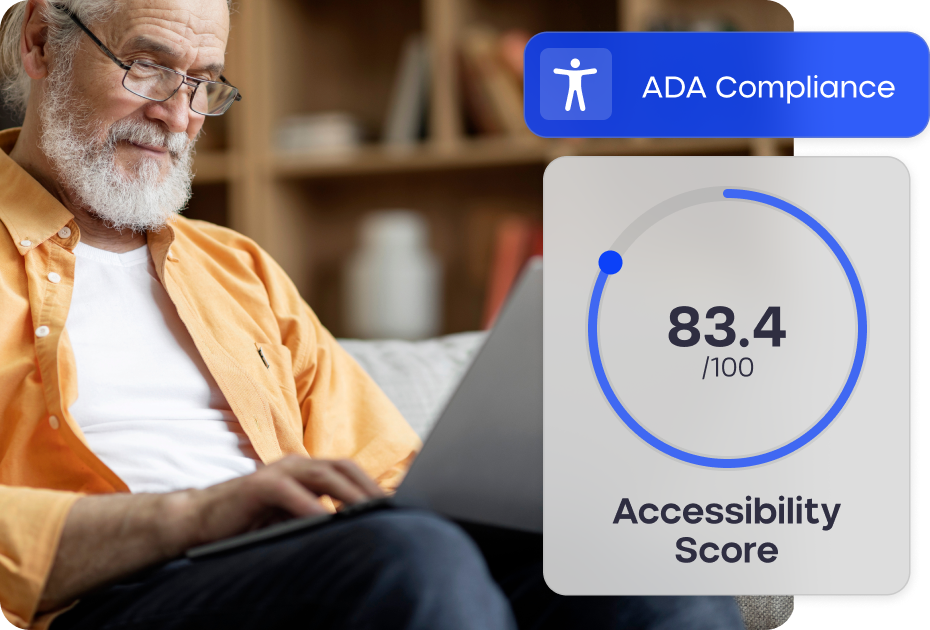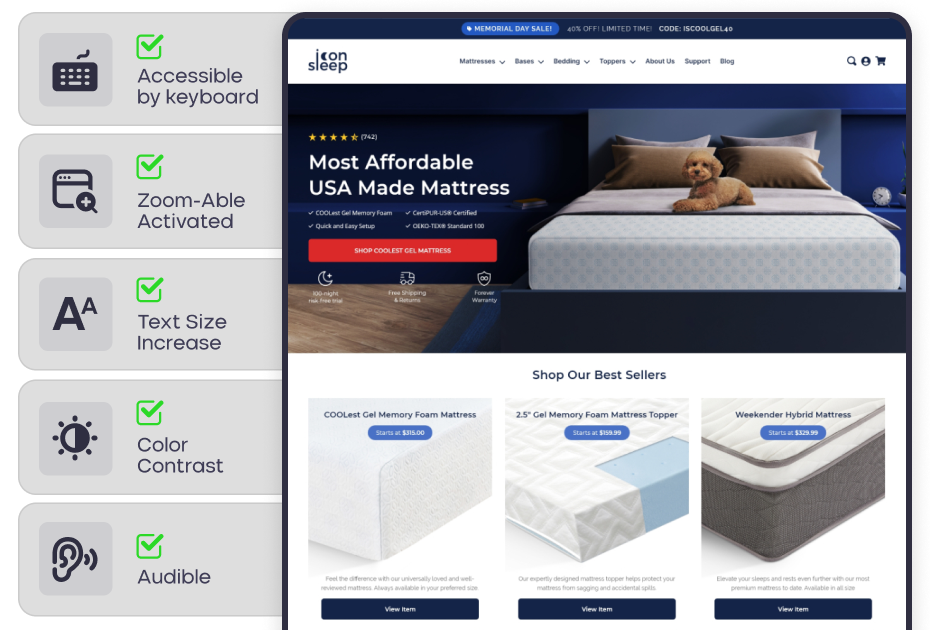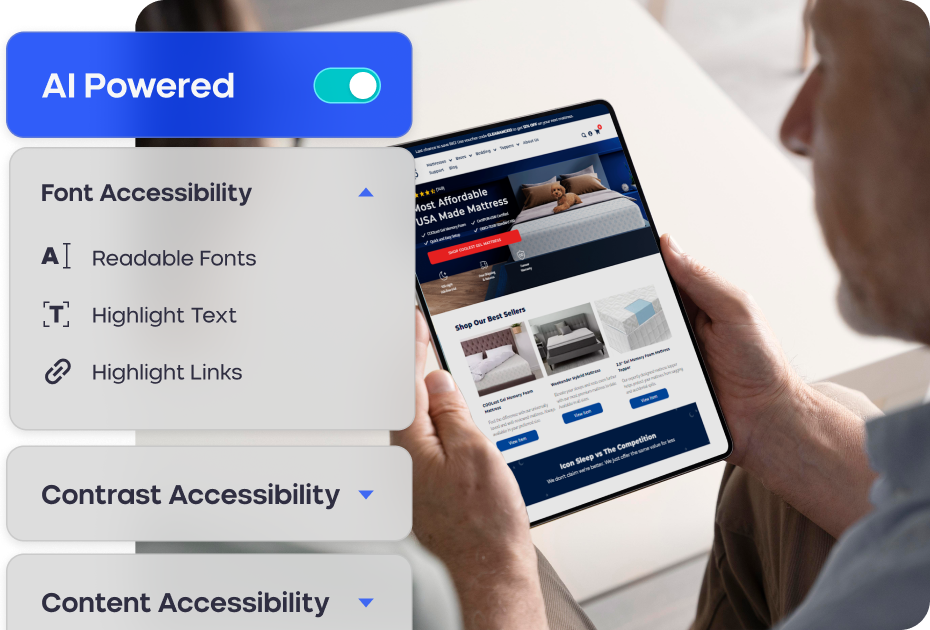Become Accessible and Compliant with Laws for People With Disabilities. Find out if your company is inclusive!


Compliance is a legal requirement,
accessibility is conscientious
Due to DOJ affirmation, websites must be accessible to people with disabilities since they are regarded as public accommodation.

Non-Compliance of Website Accessibility Can Lead to Lawsuits and Fines
Providing equal access to online content
Equal access to online content for individuals with disabilities is paramount in promoting inclusivity and diversity. Prioritizing web accessibility standards such as alt-text descriptions for images, closed captioning for videos, and keyboard navigation options guarantee that all users have the same opportunities to engage with information regardless of their physical or cognitive limitations.


ADA and Web Content Accessibility Guidelines
Generate Income with Standard Accessibility Testing
ADA Audit with Expert Recommendations and Support Included
ADA audit of website's navigation, design elements, information, and multimedia
Our proprietary ADA compliance software fully automates accessibility
Interfaces for Accessibility
Focus on providing customizable modifications to meet individual needs. Incorporating user preferences and settings allow individuals to tailor their digital experiences to best suit their abilities and limitations.
- Font sizes and color contrasts.
- Content optimization.
- Website audio.


Processes Powered by AI
AI leverage contextual understanding and computer vision models for more complex screen reader and keyboard navigation accessibility requirements. Utilizing technology accurately interprets visual information on a platform.
- Screen Reader
- Keyboard Navigation
- Automation
How Our Process Drives Revenue
We have a four-step process that helps us generate valuable content
and drive results for businesses we work with.

Step 1 – Assessment
A review of websites and other digital assets begins with a comprehensive analysis of existing content, design elements, and functionality. This evaluates the overall user experience for individuals with disabilities.

Step 2 – Monitoring
Continuous oversight and analysis of digital activities ensure they adhere to established laws and regulations. Regular audits, real-time tracking systems, and thorough documentation proactively identifies potential compliance issues before they escalate.

Step 3 – Solving
The challenges of making your website, app, videos, and documents legally compliant requires a tailored approach that considers your specific needs and budget. We prioritize necessary changes based on the impact on your business and resources.

Benefits of an ADA
Compliant Website
Frequently Asked Questions
What is ADA Compliance and what are the key requirements for an accessible website?
ADA Compliance is a set of guidelines and standards set by the Americans with Disabilities Act to ensure that people with disabilities have equal access to web content. Websites must meet certain requirements such as compatibility with assistive technologies. Other key requirements include providing captions or transcripts for audio and video content, using appropriate color contrast, and implementing proper heading structure.
What is WCAG and their main principles?
WCAG, or Web Content Accessibility Guidelines, is developed by the W3C to ensure that web content is accessible to all individuals, regardless of their abilities. These guides help websites create content that is perceivable, operable, and understandable for people with disabilities including auditory, cognitive, neurological, physical, speech and visual.
What are common barriers that people with disabilities encounter when trying to access a website?
People with disabilities face barriers when accessing websites, from technical difficulties to design and content problems. This significantly impacts the user experience, making it difficult or even impossible for individuals with disabilities to navigate and use the website. Barriers include lack of proper text alternatives for non-text content, such as images or videos, inaccessible navigation menus, poor color contrast for those with color blindness, and improper use of assistive technologies like screen readers.
How do I know if my website is designed to allow people with disabilities to easily navigate and access information?
With accessibility, you can ensure that your website is designed to be inclusive and easily navigable for people with disabilities. Our team will aid in testing and interacting with your website as users with disabilities would. Through this, you can identify barriers or challenges to make necessary changes to improve accessibility.
What are the potential consequences of not having an ADA compliant website?
Failing to have an ADA compliant website puts individuals with disabilities at a disadvantage, and opens up the possibility of legal consequences for your business. Non-compliance with ADA requirements can result in costly and time-consuming lawsuits that can damage your company’s reputation and finances. Not having an accessible website alienates potential customers who require accommodations, limiting your reach and potential for growth.
Can Always Open Commerce help us identify and fix accessibility issues on our website?
That is exactly what Always Open Commerce is here to do. Our team of experts will thoroughly analyze your website’s elements to identify any accessibility issues and provide solutions to improve the user experience for all visitors. We understand the importance of inclusivity and make it our mission to ensure that your website is accessible to everyone, regardless of their abilities. With Always Open Commerce, you can be confident that your website meets accessibility standards and provides a seamless experience for all users.

















